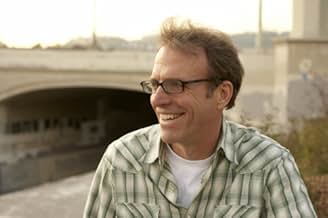ÉVALUATION IMDb
7,4/10
29 k
MA NOTE
Ajouter une intrigue dans votre langueKirby Dick's exposé about the American movie ratings board.Kirby Dick's exposé about the American movie ratings board.Kirby Dick's exposé about the American movie ratings board.
- Director
- Writers
- Stars
- Prix
- 4 victoires et 3 nominations au total
Clark Baker
- Self - Private Investigator
- (as Clark)
Avis en vedette
Fast paced, absorbing, at times comical exposé of the Motion Picture Association of America (MPAA) film rating system. While it is in name a "voluntary" system, i.e., a filmmaker can choose whether to submit a film to MPAA for rating purposes, in fact the theater chains that promise wide exposure and revenues for a film they screen will rarely touch a movie that is unrated or that receives the most restrictive rating, NC-17 (no "child" 17 or younger admitted under any circumstances.) The ratings are allegedly created by a panel of "average" parents of school age children, according to long time MPAA CEO, Jack Valenti, and other officials. There are no experts, e.g., no psychologists who study the impact of media on kids' attitudes and behavior. Panel members are selected by the rating committee chair, Joan Graves. Members' identities are kept secret to "avoid pressures" on their decision making.
Among other things, director Kirby Dick discovers that (a) there are no explicit criteria or guidelines for ratings; (b) ditto for selection of raters (who, if they work full time, receive annual salaries of $30,000); (c) one recent rater was childless; the children of several others were adults; (d) raters frequently discuss films with industry representatives, arguably the most important source of "pressure" on their decisions; (e) majority votes determine the recommended rating, but these votes are not binding; (f) in case of ties (there are eight voting members, including Ms. Graves), Ms. Graves also is empowered to cast a tie-breaking judgment; and (g) there is an appeals process.
However, the appeals board is composed exclusively of representatives of the major studios, distributors and exhibition chains, and rarely do they controvert the initial rating. This is no surprise, since the MPAA is entirely financed by the six largest studios (responsible for 90% of the films released domestically) and their conglomerate corporate media owners (who control 95% of all media outlets in the U.S.) Details of all rating board and appeal decisions are kept secret. To create the illusion of transparency, two clergymen, representing Roman Catholics and Protestants, always sit in as observers at appeals hearings. But they too are required not to disclose information on the appeal decision process.
Compared to a number of other rating systems that exist in various countries worldwide, the MPAA approach is by far the most secretive, and contrary to every other system, it is far more restrictive of sexual content than violence. Kirby Dick also cites examples that strongly suggest greater bias (i.e., greater likelihood of getting an NC-17 rating) against films depicting gay/lesbian sex scenes than those with heterosexual scenes.
Dick mixes illustrative film clips, talking heads, historical notes on the evolution of ratings, a rundown on what appear to be the implicit criteria for ratings; a stalking investigation to discover the identities of raters and appeal board members; and his personal experience in submitting an earlier cut of this film to MPAA for a rating (it got an NC-17 for sexually explicit content). Atom Egoyan, Kimberly Peirce, Kevin Smith and John Waters are among independent filmmakers interviewed by Dick. Ms. Peirce raises the interesting notion that MPAA ratings may also be more biased against films with scenes connoting female sexual pleasure than films showing male pleasure.
Dick generally maintains a tone of wry humor, especially in showing us his day-by-day use of private investigators to track down and identify raters. There's almost a Keystone Cops flavor to the stalking antics of the women PIs he has hired, with Dick along for the ride. His re-creation of phone conversations with Joan Graves and the MPAA Chief Counsel, when he protests the rating of his own film, are also as funny as they are biased. (He uses animation to visually depict these officials as mean spirited grumps in split screen scenes that simultaneously show real time footage of Dick himself at his end of these conversations.) Dick is less successful in his review of information suggesting the implicit or inferable criteria raters use, based on film content and actual ratings. He zips through too much information too fast for anybody to absorb. Still, this is a bravura piece of advocacy journalism. The film gives us ample information to conclude that the MPAA system of corporate control of ratings, when combined with control of film distribution and screening based on these ratings, effectively results in a clever censorship arrangement that would certainly violate First Amendment rights were it not for the illusion of "voluntariness" that is perhaps the most ingenious aspect of this system.
Anybody is free to make a film about anything, of course. But whether it will be screened, or even advertised, let alone able to return revenues sufficient to defray the costs of production, is a very carefully controlled process. And what is the point of making a film that will not be seen? As in political campaigning, free speech is hardly free. Those with the most corporate clout rule both the campaigning and movie making businesses. What's worse, in our characteristic American manner, we shrink puritanically from sex on screen but remain inured to the effects of violence. My grade: 7.5/10 (low B+) (Seen on 09/10/06)
Among other things, director Kirby Dick discovers that (a) there are no explicit criteria or guidelines for ratings; (b) ditto for selection of raters (who, if they work full time, receive annual salaries of $30,000); (c) one recent rater was childless; the children of several others were adults; (d) raters frequently discuss films with industry representatives, arguably the most important source of "pressure" on their decisions; (e) majority votes determine the recommended rating, but these votes are not binding; (f) in case of ties (there are eight voting members, including Ms. Graves), Ms. Graves also is empowered to cast a tie-breaking judgment; and (g) there is an appeals process.
However, the appeals board is composed exclusively of representatives of the major studios, distributors and exhibition chains, and rarely do they controvert the initial rating. This is no surprise, since the MPAA is entirely financed by the six largest studios (responsible for 90% of the films released domestically) and their conglomerate corporate media owners (who control 95% of all media outlets in the U.S.) Details of all rating board and appeal decisions are kept secret. To create the illusion of transparency, two clergymen, representing Roman Catholics and Protestants, always sit in as observers at appeals hearings. But they too are required not to disclose information on the appeal decision process.
Compared to a number of other rating systems that exist in various countries worldwide, the MPAA approach is by far the most secretive, and contrary to every other system, it is far more restrictive of sexual content than violence. Kirby Dick also cites examples that strongly suggest greater bias (i.e., greater likelihood of getting an NC-17 rating) against films depicting gay/lesbian sex scenes than those with heterosexual scenes.
Dick mixes illustrative film clips, talking heads, historical notes on the evolution of ratings, a rundown on what appear to be the implicit criteria for ratings; a stalking investigation to discover the identities of raters and appeal board members; and his personal experience in submitting an earlier cut of this film to MPAA for a rating (it got an NC-17 for sexually explicit content). Atom Egoyan, Kimberly Peirce, Kevin Smith and John Waters are among independent filmmakers interviewed by Dick. Ms. Peirce raises the interesting notion that MPAA ratings may also be more biased against films with scenes connoting female sexual pleasure than films showing male pleasure.
Dick generally maintains a tone of wry humor, especially in showing us his day-by-day use of private investigators to track down and identify raters. There's almost a Keystone Cops flavor to the stalking antics of the women PIs he has hired, with Dick along for the ride. His re-creation of phone conversations with Joan Graves and the MPAA Chief Counsel, when he protests the rating of his own film, are also as funny as they are biased. (He uses animation to visually depict these officials as mean spirited grumps in split screen scenes that simultaneously show real time footage of Dick himself at his end of these conversations.) Dick is less successful in his review of information suggesting the implicit or inferable criteria raters use, based on film content and actual ratings. He zips through too much information too fast for anybody to absorb. Still, this is a bravura piece of advocacy journalism. The film gives us ample information to conclude that the MPAA system of corporate control of ratings, when combined with control of film distribution and screening based on these ratings, effectively results in a clever censorship arrangement that would certainly violate First Amendment rights were it not for the illusion of "voluntariness" that is perhaps the most ingenious aspect of this system.
Anybody is free to make a film about anything, of course. But whether it will be screened, or even advertised, let alone able to return revenues sufficient to defray the costs of production, is a very carefully controlled process. And what is the point of making a film that will not be seen? As in political campaigning, free speech is hardly free. Those with the most corporate clout rule both the campaigning and movie making businesses. What's worse, in our characteristic American manner, we shrink puritanically from sex on screen but remain inured to the effects of violence. My grade: 7.5/10 (low B+) (Seen on 09/10/06)
Kirby Dick's expose of the MPAA's ratings process only confirms the suspicion that motion picture ratings are virtually worthless, arbitrarily assigned by an elite panel who purport to have our country's children's best interests at heart, but who seem to think that an exposed breast is more harmful to them than seeing a gunshot to the head.
It's absolutely infuriating that the country's churches have a seat on the ratings boards and a say in what content is or is not suitable for consumption. It's infuriating that an NC-17 rating exists at all (the board is essentially usurping the judgement and decision-making abilities of parents), but doubly infuriating that it's used as a punishment to "encourage" filmmakers to alter their films so that they're more palatable for mainstream film goers. For a while I was kind of sad that home video and the Internet seems to be supplanting movie theatres as the preferred venue for watching films, but now I appreciate the democratizing effect of companies like Netflix and Blockbuster, who have made great filmmakers less reliant on corporate theatre chains to get their films distributed and seen.
As a documentary, "This Film Is Not Yet Rated" is rather disorganized. Dick has good points to make, but their impact is blunted by tangents and off-topic tirades. Dick hires a private detective to track down the identities of the ratings board, and spends far too much of his 96 minutes following the details of that investigation. On the plus side, it's great to see directors and actors like Kimberly Peirce, Maria Bello and John Waters given a venue to vent their frustrations at the ratings practice.
One of the main points Dick makes, and one I heartily agree with, is that the ratings board focuses far more energy on censoring sex in films than they do violence, a point that is unintentionally driven home by none other than the ratings board chairman herself towards the film's climax. Dick asks why his documentary received an NC-17 rating and she cites the sexual content that appears in some of the clips of films that have received NC-17 ratings sprinkled throughout the documentary. She seems to have no problem with some of the very violent content included in clips from some of those very same movies. What an idiot.
Grade: B+
It's absolutely infuriating that the country's churches have a seat on the ratings boards and a say in what content is or is not suitable for consumption. It's infuriating that an NC-17 rating exists at all (the board is essentially usurping the judgement and decision-making abilities of parents), but doubly infuriating that it's used as a punishment to "encourage" filmmakers to alter their films so that they're more palatable for mainstream film goers. For a while I was kind of sad that home video and the Internet seems to be supplanting movie theatres as the preferred venue for watching films, but now I appreciate the democratizing effect of companies like Netflix and Blockbuster, who have made great filmmakers less reliant on corporate theatre chains to get their films distributed and seen.
As a documentary, "This Film Is Not Yet Rated" is rather disorganized. Dick has good points to make, but their impact is blunted by tangents and off-topic tirades. Dick hires a private detective to track down the identities of the ratings board, and spends far too much of his 96 minutes following the details of that investigation. On the plus side, it's great to see directors and actors like Kimberly Peirce, Maria Bello and John Waters given a venue to vent their frustrations at the ratings practice.
One of the main points Dick makes, and one I heartily agree with, is that the ratings board focuses far more energy on censoring sex in films than they do violence, a point that is unintentionally driven home by none other than the ratings board chairman herself towards the film's climax. Dick asks why his documentary received an NC-17 rating and she cites the sexual content that appears in some of the clips of films that have received NC-17 ratings sprinkled throughout the documentary. She seems to have no problem with some of the very violent content included in clips from some of those very same movies. What an idiot.
Grade: B+
The film rating system in this country is governed by a secret panel created by the major film studios more than 35 years ago. Since its inception the MPAA ratings board has functioned as a sort of 'black box' where movies go in one end and a rating comes out the other, with absolutely no transparency or public accountability of the process.
The MPAA rating system is publicly proclaimed to be merely a voluntary industry system that nobody is 'required' to follow. Unfortunately the reality of the movie industry is entirely divorced from these innocuous proclamations. The rating placed on a film largely determines who gets to see it in a theater, and what sort of publicity for the movie will be accepted by television and newspapers. An NC-17 basically guarantees that only the small sliver of the public with access to art house cinemas will ever sit down in a theater to watch the film, and that there will be virtually no way to promote the film to the public.
So, in the real world, the MPAA ratings board wields considerable unchecked power over the film industry. Since the organization is funded and sustained by the major studios, that influence becomes particularly problematic when applied to independent productions. It would be not unlike a small, local merchant having to go to board set up by Wal-Mart and Target to get approval for what he can put out on his shelves.
Kirby Dick approaches this subject with humor, insight, and tenacity. He undertakes to blow the lid off of the black box of the MPAA rating system. In the process he creates a narrative filled with both information and humor. While I will leave his methods as a surprise for the viewer, suffice it say they are both unconventional and effective.
The interspersing of interviews with independent filmmakers who have been forced to do battle with the MPAA to get their movies seen, provides an excellent counterpoint to Dick's quest to expose the star chamber like proceedings of the rating board to the light of day. As well, his side-by-side comparisons of similar films, one receiving an R rating and the other an NC-17, is illustrative of the particular biases present on the ratings board.
If you care deeply about he art of film, This Film Is Not Yet Rated is a must-see. On the other hand if you just want to learn a little something and have a good laugh, this is a good pick for you too.
The MPAA rating system is publicly proclaimed to be merely a voluntary industry system that nobody is 'required' to follow. Unfortunately the reality of the movie industry is entirely divorced from these innocuous proclamations. The rating placed on a film largely determines who gets to see it in a theater, and what sort of publicity for the movie will be accepted by television and newspapers. An NC-17 basically guarantees that only the small sliver of the public with access to art house cinemas will ever sit down in a theater to watch the film, and that there will be virtually no way to promote the film to the public.
So, in the real world, the MPAA ratings board wields considerable unchecked power over the film industry. Since the organization is funded and sustained by the major studios, that influence becomes particularly problematic when applied to independent productions. It would be not unlike a small, local merchant having to go to board set up by Wal-Mart and Target to get approval for what he can put out on his shelves.
Kirby Dick approaches this subject with humor, insight, and tenacity. He undertakes to blow the lid off of the black box of the MPAA rating system. In the process he creates a narrative filled with both information and humor. While I will leave his methods as a surprise for the viewer, suffice it say they are both unconventional and effective.
The interspersing of interviews with independent filmmakers who have been forced to do battle with the MPAA to get their movies seen, provides an excellent counterpoint to Dick's quest to expose the star chamber like proceedings of the rating board to the light of day. As well, his side-by-side comparisons of similar films, one receiving an R rating and the other an NC-17, is illustrative of the particular biases present on the ratings board.
If you care deeply about he art of film, This Film Is Not Yet Rated is a must-see. On the other hand if you just want to learn a little something and have a good laugh, this is a good pick for you too.
A look into the mysterious organization that decides what rating a film is given. And all sorts of other issues/arguments that are created because of it. Numerous actors, directors, producers, former MPAA raters and critics share their thoughts on the good and bad of the highly secretive organization.
I have always found "rating reasons" funny and often absurd, which is why I make my own when writing these things. I have also always liked to look into second opinion on things so maybe whoever reads my little IMDb reviews will get that from them. Since, the often disturbing fact for film makers is the rating is something they have to live with and discussing it with the people who decided it is virtually not an option. And that ultimately decides what theaters decided to show it and how much, which is essentially how films money.
The reason as many of you know for the infamous NC-17 rating is sexual content, especially if it is explicit, and that is basically the focus of this film. Which is both good and bad. Good, because they do a pretty good job comparing R-rated and NC-17 rated sex scenes which are not that different. But bad, because the issue of violence (in my opinion the most potentially objectionable thing shown in film) is attended to on a small scale. There are violent PG-13 movies (Ah-nuld's "The 6th Day" for one) which include bone breaking, dismemberment, and you get the picture. While on the other side you have R-rated movies with really minimal or much more accurate depiction of violence (Michael Mann's "Heat" for one). Yet violence as entertainment is condoned, but showing kids what violence really looks like is not. Darren Aronofsky and Kevin Smith make the film's only points on violence and it'll leave you wanting for more.
Also there wasn't a comparison to other countries rating system, just a mention that those systems are a little less absurd, which is true if you look at the rating sections on most IMDb film profiles, but some thought here would have been invaluable to this film's argument.
However, this remains a pleasantly fresh documentary that many, but mainly John Waters (haha), have been waiting for. 8/10
Not Rated, contains: sexual material and some violent clips - There are many clips of sex scenes shown, but are shown and discussed from a critical perspective. The few violent scenes are discussed in the same manner. So bring your kids! They'll finally know what "it's not for you" means.
I have always found "rating reasons" funny and often absurd, which is why I make my own when writing these things. I have also always liked to look into second opinion on things so maybe whoever reads my little IMDb reviews will get that from them. Since, the often disturbing fact for film makers is the rating is something they have to live with and discussing it with the people who decided it is virtually not an option. And that ultimately decides what theaters decided to show it and how much, which is essentially how films money.
The reason as many of you know for the infamous NC-17 rating is sexual content, especially if it is explicit, and that is basically the focus of this film. Which is both good and bad. Good, because they do a pretty good job comparing R-rated and NC-17 rated sex scenes which are not that different. But bad, because the issue of violence (in my opinion the most potentially objectionable thing shown in film) is attended to on a small scale. There are violent PG-13 movies (Ah-nuld's "The 6th Day" for one) which include bone breaking, dismemberment, and you get the picture. While on the other side you have R-rated movies with really minimal or much more accurate depiction of violence (Michael Mann's "Heat" for one). Yet violence as entertainment is condoned, but showing kids what violence really looks like is not. Darren Aronofsky and Kevin Smith make the film's only points on violence and it'll leave you wanting for more.
Also there wasn't a comparison to other countries rating system, just a mention that those systems are a little less absurd, which is true if you look at the rating sections on most IMDb film profiles, but some thought here would have been invaluable to this film's argument.
However, this remains a pleasantly fresh documentary that many, but mainly John Waters (haha), have been waiting for. 8/10
Not Rated, contains: sexual material and some violent clips - There are many clips of sex scenes shown, but are shown and discussed from a critical perspective. The few violent scenes are discussed in the same manner. So bring your kids! They'll finally know what "it's not for you" means.
America is the land of the free, so in order to constrain people to do what you want them to do, you have to let them think it's their choice. How do you do that? You create a completely anonymous committee, supposedly composed of concerned parents, to rate the films that appear and, depending on that rating, they will get more or less media coverage, distribution, target audience size. You also finance this body with the money of the seven largest film studios in the US. This functioning censorship committee is called the MPAA.
The film is highly biased, to a point where it gets a little annoying, but the information contained in it is sound, proved and makes one think about the way public opinion is manipulated, ever so slightly, towards a desired average point of view. If you ever wondered how Americans can seem so ordinary, yet have completely different opinions about the same subjects as any other people, then this movie will answer part of that question. Very insightful is the presentation of the seven major film studios who own 95% of the American film industry, parts of larger conglomerates that own 90% of all mass-media. Also interesting, the role of the clergy in movie rating. Yes, I did say clergy, as in priests. In the appeals commission there are always an episcopalian priest and a catholic one. No other religions get to add their input.
A must see movie, not a conspiracy theory film, but certainly one that is against the system. The system here being the absurd movie rating system of the MPAA.
The film is highly biased, to a point where it gets a little annoying, but the information contained in it is sound, proved and makes one think about the way public opinion is manipulated, ever so slightly, towards a desired average point of view. If you ever wondered how Americans can seem so ordinary, yet have completely different opinions about the same subjects as any other people, then this movie will answer part of that question. Very insightful is the presentation of the seven major film studios who own 95% of the American film industry, parts of larger conglomerates that own 90% of all mass-media. Also interesting, the role of the clergy in movie rating. Yes, I did say clergy, as in priests. In the appeals commission there are always an episcopalian priest and a catholic one. No other religions get to add their input.
A must see movie, not a conspiracy theory film, but certainly one that is against the system. The system here being the absurd movie rating system of the MPAA.
Le saviez-vous
- AnecdotesThe MPAA announced that starting in March of 2007, it will change their policy and allow filmmakers to cite other film's ratings as comparison. The MPAA will also provide information about the demographics of its board.
- Citations
John Waters: I also heard on 'A Dirty Shame' - and I have no proof of this - that there were doctors involved... and that some of the kinkier terms, like felching and stuff, that they explained to the MPAA what felching meant. Now, I would like to have heard that because felching, no one has ever done felching. Felching is when you fuck someone and suck your own cum out of their asshole. Well, I know a lot of perverts and I don't know anyone who's done that.
- Générique farfeluAt the end credits a count of what the film shows: FUCKS(OR DERIVATIONS OF): 20 MOTHERFUCKERS: 3 HUMPS: 220 NIPPLES: 10 INTERCOURSE WITH PIE: 1 CARTOONS/PUPPETS IN SEXUAL POSITIONS: 15 SPLOSHING: 1 FELCHING: 0
- ConnexionsEdited into This Film Is Not Yet Rated: Deleted Scenes (2009)
- Bandes originalesAppeals Members
Written and Performed by Michael S. Patterson (ASCAP)
Courtesy of Absynthe Zelery Music (ASCAP)
Meilleurs choix
Connectez-vous pour évaluer et surveiller les recommandations personnalisées
- How long is This Film Is Not Yet Rated?Propulsé par Alexa
Détails
- Date de sortie
- Pays d’origine
- Langue
- Aussi connu sous le nom de
- Los censores de Hollywood
- Lieux de tournage
- sociétés de production
- Consultez plus de crédits d'entreprise sur IMDbPro
Box-office
- Brut – États-Unis et Canada
- 306 845 $ US
- Fin de semaine d'ouverture – États-Unis et Canada
- 30 664 $ US
- 3 sept. 2006
- Brut – à l'échelle mondiale
- 347 240 $ US
- Durée1 heure 38 minutes
- Couleur
- Mixage
- Rapport de forme
- 1.85 : 1
Contribuer à cette page
Suggérer une modification ou ajouter du contenu manquant

Lacune principale
What is the Brazilian Portuguese language plot outline for This Film Is Not Yet Rated (2006)?
Répondre






























